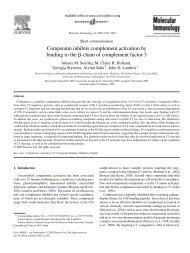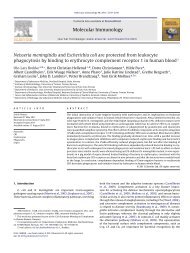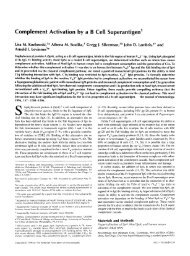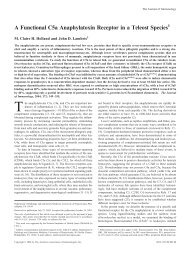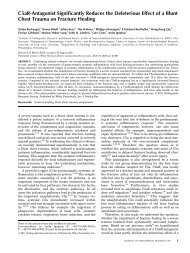IDENTIFICATION OF A C3bi-SPECIFIC ... - John D. Lambris
IDENTIFICATION OF A C3bi-SPECIFIC ... - John D. Lambris
IDENTIFICATION OF A C3bi-SPECIFIC ... - John D. Lambris
You also want an ePaper? Increase the reach of your titles
YUMPU automatically turns print PDFs into web optimized ePapers that Google loves.
GORDON D. ROSS AND JOHN D. LAMBRIS 105<br />
human neutrophil elastase. STI and PMSF also allowed E<strong>C3bi</strong> rosette formation with<br />
mature neutrophils. Second, in the absence of protease inhibitors, E<strong>C3bi</strong> that had<br />
been incubated with neutrophils lost all detectable C3c antigens while retaining C3d<br />
antigens and the ability to bind to lymphocyte CR2. This indicated that neutrophil<br />
enzymes cleaved E<strong>C3bi</strong> to EC3d. Finally, when neutrophils were fractionated into<br />
cells with band form nucleus and polymorphonuclear cells, it was found that STI did<br />
not enhance E<strong>C3bi</strong> rosette formation with band form cells, whereas with polymorphs,<br />
more STI was required to allow E<strong>C3bi</strong> rosettes with high density (1.12 g/ml) mature<br />
polymorphs than with low density (1.09 g/ml) less mature polymorphs. Elastase has<br />
been detected in azurophilic myeloid cell granules by immunofluorescence at the<br />
promyelocyte stage of maturation (37). However, promyelocyte elastase is probably<br />
not secreted, and polymorphs apparently release azurophilic granule enzymes only at<br />
the site of contact with serum-opsonized bacteria (28). Because binding of opsonized<br />
bacteria probably involves Fc receptors, CRI, and CRa, one of these three types of<br />
receptors on mature cells may have the ability to trigger elastase secretion. Because of<br />
this elastase-secreting activity, neutrophils in vivo are probably unable to bind<br />
particles that contain only <strong>C3bi</strong>, and therefore it is presumed that CRa is not<br />
important for neutrophil phagocytosis. Because CRa apparently binds a small trypsinor<br />
plasmin-derived <strong>C3bi</strong> fragment, it is possible that such an active fragment may be<br />
generated by <strong>C3bi</strong> proteolysis in vivo, and that this fragment may be responsible for<br />
triggering some neutrophil function other than phagocytosis.<br />
Monocytes resembled neutrophils in that they expressed CRa and CRa and lacked<br />
detectable CR2. Unlike neutrophils, monocytes did not require protease inhibitors to<br />
allow EC3hi rosette formation. Furthermore, other studies have demonstrated that<br />
human macrophages (31) and rat mast cells (38) ingest <strong>C3bi</strong> complexes much more<br />
efficiently than C3b complexes. Thus, these other phagocyte types differ from neutrophils<br />
in that CRa appears to be more important than CR~ for phagocytosis in vivo.<br />
CRa were also detected on the majority of human erythrocytes. In the past, human<br />
erythrocytes were thought to express only CR1 and not to bind <strong>C3bi</strong> or C3d complexes.<br />
Gaither et al. had noted reduced human erythrocytes immune adherence with<br />
EAC43bi as compared with EAC43b (39). However, it was not clear whether this<br />
<strong>C3bi</strong>-dependent immune adherence was due to a distinct <strong>C3bi</strong>-specific receptor or<br />
rather a low affinity binding of <strong>C3bi</strong> to CR1. Indeed, human E-rosette formation with<br />
E<strong>C3bi</strong> or EAC1-3bi is difficult to demonstrate, as it is such a weak reaction. In the<br />
present study, <strong>C3bi</strong>-ms were prepared with purified <strong>C3bi</strong> fragments containing no<br />
detectable C3b by SDS-PAGE and were shown to bind to nearly all human erythrocytes<br />
in the presence of amounts of anti-CR1 that were sufficient to inhibit C3b-ms<br />
binding completely.<br />
Cells of the human renal glomerulus apparently also express both CR1 and CR3.<br />
Carlo et al. have demonstrated that kidney cells bind both EAC43b and EAC43bi<br />
but not EAC43d (40). Also, it has recently been demonstrated that renal epithelial<br />
cells are fluorescence stained with F(ab')2 anti-CRx (M. Papamichail, J. D. <strong>Lambris</strong>,<br />
and G. D. Ross, unpublished observation).<br />
Lymphocytes differed from all the other cell types examined in that they expressed<br />
CR2 in addition to CRa, and <strong>C3bi</strong> complexes were primarily bound to CR2 rather<br />
than to CRa. For this reason, specific assay of lymphocyte CRa required complete<br />
blockade of membrane CR2 with anti-CR2 before assay of CRa with E<strong>C3bi</strong> or <strong>C3bi</strong>-<br />
Downloaded from www.jem.org on November 8, 2004





